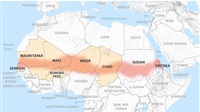Sumo's heaviest ever wrestler urges others to keep eating habits in check

Japan’s sumo wrestlers should rein in their enormous
appetites and take better care of their health. The advice comes not from
doctors or nutritionists, but from a former wrestler who weighed more than any
other man in the sport’s long history.
“It’s never easy to stay healthy as long as you’re
living the life of a sumo wrestler,” Ōrora,
a retired professional wrestler, or rikishi, said in a recent interview with
the Asahi Shimbun, soon after a young wrestler died after contracting
coronavirus. “You
are the only person that can take care of yourself. Nobody in your sumo stable cares
about you.”
The Russian wrestler, who now uses his “civilian”
name, Anatoly Mikhakhanov, said the sumo route to gaining weight – two
gargantuan meals a day separated by an afternoon nap – was putting wrestlers’
health at risk.
The dangers of a lifestyle that combines intense
physicality and bulk-building food intake were underlined last month when
Shobushi, a wrestler in one of the lower professional ranks, died from
Covid-19. Doctors who treated the 28-year-old said he had several chronic
health conditions.
The sumo diet staple chanko nabe – a stew packed
with meat, fish and vegetables – is high in protein and low in fat. But
Mikhakhanov, who retired in 2018, knows to his cost how pressure to pile on the
pounds can tempt wrestlers into consuming more than the 4,000 calories they
need to refuel after gruelling early-morning training sessions.
Weighing an already hefty 190kg when he turned
professional, Mikhakhanov saw his weight increase to 292.6kg shortly before he
retired. In 2017, he became the heaviest professional rikishi ever at 288kg,
beating the record previously held by the Hawaii-born Konishiki, who tipped the
scales at 285kg.
Mikhakhanov would routinely polish off 200 pieces of
sushi and a crate of beer, and found it impossible to refuse offers of extra
bowls of rice from senior stablemates. As a result, he suffered from
hypertension and struggled to fight off fatigue.
“I would lie down right after eating, which wasn’t
good,” he told the newspaper. “Just walking or moving was really troublesome.”
The 37-year-old has since swapped his two huge meals
a day for five smaller meals, and regular walks and gym sessions have helped
him shed more than 100kg. “Of course, you can’t train unless you eat, but
there’s no point in making yourself ill,” he said.
Mikhakhanov was not alone in struggling to keep his
eating habits in check. “Wrestlers in the highest makuuchi division weigh and
average of 160.2kg – 15kg heavier than three decades ago, and have an average
body mass index of more than 47, while medical professionals warn that a BMI of
30 or higher indicates obesity.
With hundreds of wrestlers divided into 45 stables,
some are bound to let temptation get the better of them, according to John
Gunning, a former amateur sumo wrestler who now commentates and writes about
the sport in Japan.
“Some are extremely diligent about what they eat;
some aren’t,” says Gunning, whose weight doubled to 120kg within two years of
making his debut in 2004. “The bigger and heavier you are the better you’ll be.
This is not an aerobic sport. If you want to be good you have to get big, and
that can come at the expense of your health.”
While other intense contact sports such as rugby and
American football have adopted new approaches to training and nutrition,
Japan’s de facto national sport is anchored to tradition.
“There is pressure on wrestlers to get bigger and
stronger, but there has been no significant change in training methods or
nutrition,” says Gunning, who represented Ireland three times at the sumo world
championships. “They’re doing the same exercise routines, eating the same
things and living the same lifestyle as 20 years ago … or 200 years ago.”
The Japan Sumo Association has published 10 health
guidelines that include eating fish and vegetables, in addition to meat,
chewing food properly and avoiding crisps, cakes and other snacks. The
association conducts regular health checks on wrestlers, but enforcing good
eating habits is practically impossible among stables with contrasting
attitudes towards nutrition and health.
“Most wrestlers are in their late teens and early
20s in a testosterone-fuelled support. They’re fighting every day and they
don’t have much freedom,” says Gunning. “The pressure builds but there’s no way
to release it. Overeating relieves stress and gets you big. I did it myself.”







